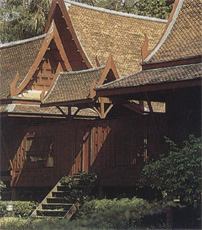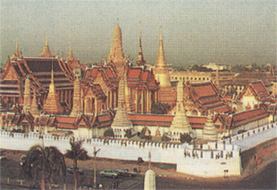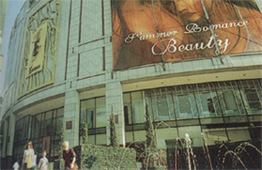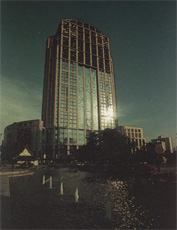|
|
|
The Arts
|
A traditional Thai house
Early Sukhothai monuments were
strongly Khmer-influenced. In the Khmer
manner, sandstone was used to form
door parts, lintels, and rectangular
windows.Around the 12th century, brick
replaced sandstone as the favoured
building material. Bricks were carefully
laid without mortar, bound with vegetable
glue. and then sheathed in carved stone.
Later, architects used stucco, a sand,
lime, and glue mixlure strengthened by
a terra cotta armature, to cover the brick
walls. In the heavily forested north, wood
was employed in temple construction and
craftsmen attained great skill in carving
decorativeeiements.
 |
A traditional Thai house
|
Chinese influence can also be seen
in ornamental decoration, particularly
the use of porcelain fragments in various
colours and adornments that afford the
finest Thai architecture its harmonious,
polychromatic etfect. This art reached
its highest expression during the first
half of the 19th century.
Materials such as glass mosaic
pieces highlighted gables and pillars, as
well as wooden and stucco figures, and
other decorative techniques utilized
lacquer, gilt, mother-of-pearl inlay, gold
leaf, and porcelain fragments to obtain
the desired effect of gleaming elegance.

A Grand Palace, a repository of classic Thai architecture and decoration
|
The most spectacular Buddhist
architecture is to be seen at Bangkok's
Wat Phra Keo (Temple of the Emerald
Buddha) which contains more exquisite
carving and decoration per square
centimeter than any comparable site in
the world. Within the temple compound,
almosi every surface is covered with
inspired decoration. Incorporating so
many colours and materials, the complex
is a near psychedelic yet unified mixture
of multi-tiered ochre, blue, orange, and
green tiled roofs, towering ranged
dragons staring at a golden Ayutthaya-style chedi, marble prangs, priceless
mother-of-pearl inlaid doors, bronze
lions, gilt Garudas, Chinese statuary, and
tiny tinkling bronze wind bells suspended from scarlei and gold-lacquered
eaves and is, above all, the Thai ideal of
a skilfully-arranged complex imparting
reverence and serenity.

Wat Benchamabophit, an outstanding example of modern Thai Buddhist architecture
|
Wat Benchamabophit (the Marble Temple), also in
Bangkok, is reknowned
as the most impressive example of
modern Thai Buddhist architecture,
Built in 1899 by King Chulalongkorn,
the temple is constructed of white
Italian marble and surmounted by
multi-tiered orange tiled roofs.

Western-style architecture now predominates in large cities
|
In addition to religious structures,
a distinctive Thai style of domestic
architecture also evolved, employing
prefabricated panels hung on a frame-work of stout pillars and using wooden
pegs instead of nails for joining.
Various forms developed in different
regions of the country, perhaps the best
known being the central plains style with
its steep roofs, decoratively -carved
bargeboards, and slightly in ward-leaning walls that give it a
memorable sense of elegant grace.
 |
A contemporary skyscraper in Bangkok
|
Like other forms of art in recent
years. Thai architecture has been
revolutionized by new industrial
materials and by the example of the pure
functional of machines. Modern
Thai architects seem to be guided by
Western principles of structure, plan,
and funciionalism, so that their works
resemble those to be seen in any large
city of the world, reflecting not only
individual taste but also such matters as
zoning regulations, ecology, and energy
consumption.
| | |
|
|